Nature & Environment 2004
Foreword

Protection of nature over the last 20 to 30 years has born fruit in a number of areas. For example, targeted efforts to establish new forests have been successful, benefiting plant and animal life, outdoor recreation, and protection of our groundwater.
However, there are also areas in which special efforts are still needed in order to preserve and restore biological diversity. In 2004, the National Environmental Research Institute updated Denmark's Red List of threatened species, now with a total of 2,465 species of Danish fungi, insects, spiders, and birds. The update revealed that one in every four species is either considered to have disappeared or to be threatened to a greater or lesser extent.
One major challenge in a small and densely populated country like Denmark is to balance successfully protection of nature with our way of life, including how we use the land and nature. It is our goal to halt the decline in biological diversity by 2010 at the latest.
Therefore, protection and management of nature will be a top priority for large parts of Denmark in the years to come, not least for the so-called NATURA 2000 sites, which, together, form an ecological network of protected natural areas throughout the EU. Naturally, this will not be without cost.
The Danish Government places great emphasis on an active nature policy. We have therefore set aside an extra DKK one billion (EUR 0.134 billion ) over the next four years for e.g. nature restoration, safeguarding important habitats for plants and animals, establishing more forests, and enhancing efforts for cleaner water.
Furthermore, in seven of Denmark's important natural sites, the Government has initiated work to develop a Danish model for national parks in which nature, outdoor recreation, cultural history, housing, and trade and industry exist side by side. Local work will be completed during the summer of 2005, and the Government will subsequently propose a bill for the establishment of national parks in 2006.
To make all this reality and a success, each and every one of us must take responsibility and join in the effort. The Government will do its share, the municipalities will have to meet greater responsibilities, agriculture must develop to impose a lesser burden on nature and the environment, and the individual Dane must show commitment and share in the responsibility.
Connie Hedegaard
Minister for the Environment
Introduction
Walks to the woods, the countryside, round a lake or along the beach; these are recreational activities that most of us enjoy on a regular basis without further ado. We value nature and welcome the experiences it brings us. Cost-benefit analyses show that if required to, Danes would pay up to 300 (EUR 40) for an annual license to visit the woods, and they show that house prices tend to increase considerably (by up to DKK 200,000 (EUR 26,827)) for houses situated on land bordering a forest.
However, cities, infrastructure, and agriculture have put nature under pressure. In order to compensate for this pressure and preserve a diverse and rich nature, it is important that we take care of and protect nature. Measures that contribute to this include nature restoration, financial support to environmentally friendly farming and farmers who improve their nature and landscape management.
We live in a constructed or cultivated landscape, and agriculture is responsible for three-quarters of Danish landscapes, i.e. fields, forests and natural areas. Consequently, when agriculture changes its production practices, nature and the landscape change as well. This means that the rare and richly diverse vegetation on the almost 200,000 hectares of meadows and dry grasslands is in the process of becoming overgrown by scrub. Here, efforts to safeguard plant and animal life are required.
As part of efforts to improve the protection of nature and reduce environmental pressures, leaching and runoff of nitrogen to lakes and watercourses from fields have been halved, and ammonia volatilisation has been reduced by one-third. However, more is required, if we are to arrive at the quality of nature and the environment that we desire, and if we are to live up to the EU requirements for nature and the environment set out in the Water Framework, Birds, and Habitats Directives.
Expected climate change in Denmark points to a warmer, more humid and windier climate, including more storms and prolonged periods rainfall. Man-made climate change influences virtually all the Earth's
ecosystems. The first effects documented in nature are changes in the amount and rhythm of water (runoff). Changes in precipitation and runoff will,
if they continue, have great impacts on draining in river valleys, loss and leaching of substances, and on ecological conditions in watercourses, lakes, and fjords. Furthermore, a spread of plant species from
southern into northern Europe due to the rise in temperatures has been observed, putting further pressure on the function of ecosystems and valuable natural assets.
Many sectors of society are involved in shaping the Danish landscape, and many interests conflict when the use of land and nature for different purposes have to be prioritised. Land is a scarce resource in Denmark, but by duly considering e.g. the quality of our landscapes, the condition and function of ecosystems and the need for biological diversity, we can make our production and consumption practices friendly toward nature and the environment, and thus be able to leave the Earth in as good a state as we received it. It is also a prerequisite that we limit the global emissions of greenhouse gases in order to prevent the consequences they pose to nature through changes in the climate.
Public commitment to sustainable management and protection of nature is crucial if we are to reach the results desired. Education and communication, as well as better opportunities for good nature experiences and outdoor recreation, are paramount if we are to make the often very complicated interrelationships in nature commonly known and appreciated.
This year, the indicator report evolves around the theme ”protection of Danish nature”. The theme booklet illustrates e.g. trends in selected species, the area of valuable, Danish natural areas, the most dire threats to nature, etc. Furthermore, in the form of overviews the theme booklet describes the measures which the Ministry of the Environment is setting in motion in order to protect nature. The theme is described through 18 selected indicators. The overall set of indicators, comprising about 70 indicators for nature and the environment, can be viewed on the Internet.

Collaboration on nature protection in the EU
The Birds and Habitats Directives
The Birds and Habitats Directives contain 2 main principles for the protection of nature in Europe:
- Member States must designate, protect, and manage special protection areas that contain species and habitats which at European level have been agreed upon as worthy of protection.
- Member States must protect specified species against collection, extinction, exploitation, etc., as well as protect their breeding sites and resting places from damage and destruction.
Denmark has designated a total of 254 habitat areas and 113 bird protection areas, on land and at sea.
Natura 2000
NATURA 2000 is a generic term for bird protection areas and habitat areas.
The EU Water Framework Directive
The EU Water Framework Directive, which entered into force on 22 December 2000, lays down a new framework for protection of the aquatic environment. In December 2003, the Danish Parliament adopted a new Environmental Targets Act, implementing the Directive in Danish legislation. The objective of the Water Framework Directive is to ensure the protection of watercourses, lakes, transition waters, coastal waters, and groundwater.
Source: Danish Forest and Nature Agency, Danish EPA
Land use
Land use in Denmark has changed considerably over time and is still changing. Urban areas and road infrastructure have expanded at the cost of meadows, dunes, marshes, and lakes. Arable land still accounts for the greater part of the landscape, covering 62 per cent, but this share is diminishing.
In many places today, forest is being established on former arable land, so that, now, a total of 11 per cent of Denmark is covered by forest.
The general trend
Viewed over a decade, land use in Denmark has changed radically. The area of built-up land has increased significantly, and the land area taken up by road infrastructure, arable land, and mineral resources exploitation has also increased. Land reclaim projects have drained almost 200,000 hectares of lakes, fjords, and wetlands. Today, arable use of these marginal land types is in decline and in many cases not financially feasible, e.g. because of the extra costs associated with continuous draining.
Our use of the land in Denmark is still subject to change. For example, we are establishing new forests and erecting new housing on former arable land. Furthermore, there is a continuing trend in terms of fewer but larger farms, and as the result of continued intensified cultivation, fields are becoming ever larger, reducing the number of e.g. field tracks, hedgerows, and small biotopes etc.
Agriculture
Denmark is very much a farm land today, as it was a hundred years ago. This is true even though the area of cultivated land has gone down from 74 per cent in 1920 to 62 per cent today.
The total number of farms in agriculture has fallen from 92,000 in 1985 to 46,500 in 2003. This development could be explained by three overall trends: intensification, specialisation, and concentration. Each trend contributes to changes in the landscape and nature. Danish farm landscapes are changing structurally as the number of farms falls and the size of the remaining farms increases. Via this concentration of arable land on few farms, a homogenisation of the landscape is taking place, as there is a significant correspondence between the size of the farm and the average size of the individual field.
Furthermore, during the last decade, a change from cattle to pigs has occurred in livestock farming. In 2003, Denmark produced 24.4 million pigs. In January 2004, the Danish pig stock totalled about 13 million; a 24-per-cent increase from 1990. The increase in the number of pigs over the last decade has happened primarily in western Jutland, whereas northern and western Zealand have seen a decrease. The number of cattle and sheep has decreased, and this decrease has been most significant in Jutland.
Livestock farms account for three-quarters of ammonia emissions from agriculture. Regional specialisation of agriculture production in Denmark and the subsequent differences in livestock density between Eastern and Western Denmark mean that nutrient-poor heaths in Western Jutland have become particularly threatened by over-fertilisation caused by ammonia emissions from manure. Heaths require nutrient-poor growth conditions and are therefore vulnerable to ammonia, which serves as a nutrient.
Overall a number of environmental impacts from agriculture have been reduced during the last decade, while at the same time agricultural production has been relatively stable, showing a slight fall over time. For example, energy consumption by agriculture has gone down, as has pesticide treatment frequency (number of sprays each year) and nitrogen input. Nitrogen leaching and runoff to watercourses and lakes over the last 10 to 15 years have been halved, amongst other things as a result of action plans for the aquatic environment, and ammonia volatilisation has been reduced by one third. However, impacts are still high.
Nature and forests
The proportion of natural area has fallen dramatically over the past 100 years. Open-land habitats such as meadows, dry grasslands, dunes, coastal meadows, heaths, marshes, and lakes covered almost 60 per cent of Denmark 200 years ago. Today, these habitats cover only about 10 per cent of Denmark. The area of forest reached a low point around 1800, where only about four per cent of forest in Denmark was left. However, since then the area of forest has been growing, reaching somewhere around 11 per cent in 2000. Today, in many places throughout Denmark forests are being established on former arable land.
Changes in land use
Many changes in land use in Denmark come from changes to existing arable land and forest.
Due to the storm in December 1999, large areas of forest were subject to windfalls. Areas with conifers, which are most vulnerable to storm damage, were hardest hit. Transition forest is a classification for young forests in growth and forests which have been degraded due to e.g. windfalls. A total of 6 per cent of the overall area of forest in 1990 had become transition forest in 2000.
A total of around 20,000 hectares of arable land have gone over to different land use. Of this 20,000 hectares, 10,000 hectares now fall under the categories of cities, commerce and industry, and sports and recreational areas, including areas with summerhouses. Even though these changes pertain only to 0.2 per cent of Denmark's total area, they nevertheless stress the general trend toward more housing at the cost of the open countryside.
More than 6,000 hectares of arable land have become transition forest, a change linked to afforestation efforts. Furthermore, 1,750 hectares of arable land have changed into wetlands and lakes, which is most likely due to wetland restoration efforts.
These figures are from the Corine Land Cover Inventory, based on interpretation of satellite imagery. Since the minimum size of areas registered in the Corine Inventory is 25 hectares, we primarily know of changes on the large, cohesive areas that have been registered. Changes on areas less than 25 hectares have therefore not been included and, consequently, the overall scope of changes in land use is probably underestimated in the Corine Inventory. Nevertheless, the figures imply general development trends which are supported by other statistics.
Source: National Environmental Research Institute (NERI), Miljøtilstandsrapport 2005 (The State of the Environment in Denmark 2005)
1 DISTRIBUTION OF AREA
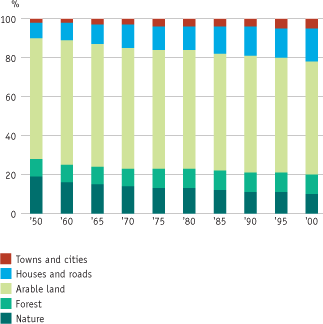
Source: Statistics Denmark
The graph shows developments in the area distribution between 1950-2000, broken down into five area types: nature, forest, farmland, houses and roads in the open countryside, and finally towns and cities.
The proportion of natural area has fallen dramatically over the past 250 years. Today, only 10 per cent of the area is covered by natural areas such as dunes, heaths, marshes, meadows, and lakes. Natural areas in this category are protected by legislation against further decline in area. The dramatic decline in the area of these types of natural habitat has thus been stopped. The objective is to curb the decline in biodiversity (i.e. the decline in the area as well as the quality of nature) by 2010.
The area of forest reached a low point around 1800, where only about four per cent of forest in Denmark was left. The area of forest has been increasing ever since and today constitutes almost 500,000 hectares, which is about 11 per cent of the total land area of Denmark. In 1989 a political decision was made that the area of Danish forests should be doubled in 80-100 years. The area of forest has been on the increase since 1989, but the increase is still not large enough to be apparent from the graph.
The area of arable land has been constant since 1950 and today takes up about 62 per cent of Denmark. Fields in Denmark take up more space in relation to the total area than any other country in Europe. Many wetlands have been drained in order to allow space for agriculture or forestry. Today, 80 per cent of the total land area of Denmark is affected by draining, and only four per cent of the country is covered by marshes, bogs, and water meadows. Many lakes and watercourses have also disappeared because of draining. The proportion of the land area taken up by roads and housing has increased significantly, not least since 1950. As the land area of Denmark is used more intensively than in other countries, efforts are being done to combine and integrate to a greater extent the different considerations in land use, including considerations for nature.
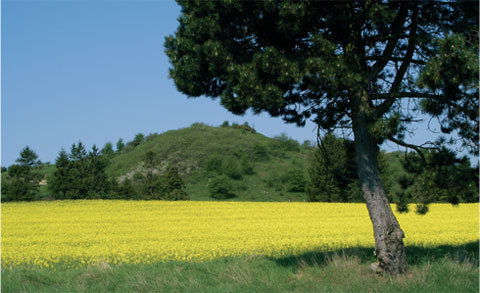
2 DRAINAGE
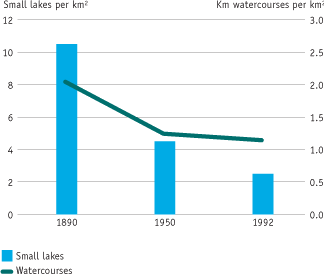
Source: Funen County
Many small lakes and watercourses have disappeared from the landscape as a result of draining. The bars show the development of the area around Lake Arreskovsø on Funen.
Over the past 100 years, the extent of open watercourses in Denmark has fallen dramatically because digging ditches and watercourses into pipes, and straightening watercourses, has made them shorter. For example, on the basis of old maps it has been calculated that the length of the watercourses in the catchment area for Hundstrup Å, a river in southern Funen, fell from about 174 kilometres in 1890 to about 97 kilometres in 1992.
Draining wetlands, etc. for cultivation has also had a great impact on the number and size of lakes and fjords on Funen. In the catchment area for Lake Arreskovsø the number of smaller lakes and waterholes has fallen from 276 to 65 over the past 100 years. This development has dramatically reduced the habitats for animals and plants.
Overall, a great number of wetlands have been drained to deliver land to agriculture or forestry, and land reclaim projects have thus laid dry almost 200,000 hectares lakes, fjords and other wetlands in Denmark. The natural interplay between watercourses and meadows, with periodical flooding of watercourses to fertilise meadows, now only occurs in very few places in Denmark. The Danish Protection of Nature Act from 1992 has stopped the direct draining of small lakes and marshes, and today farmers can only recover groundwater for watering fields.
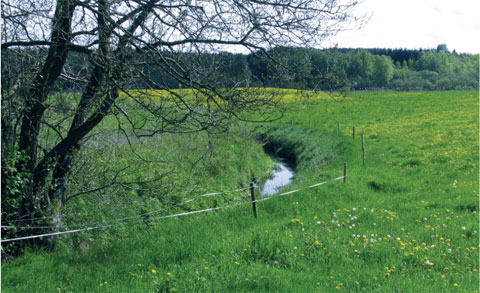
3 SIZE OF FARMS AND FIELDS
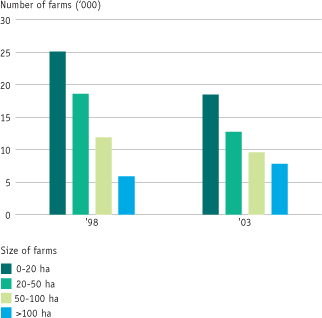
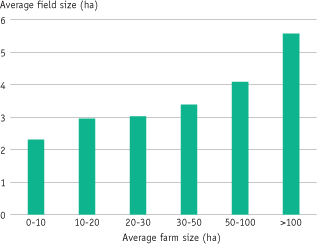
The figure shows the trend in sizes of farms from 1998-2003 (at the top) and the average size of fields relative to the average size of farms in 2003 (below). The development in agriculture is characterised by concentration of production on still fewer farms, which in turn are growing ever larger. The large farms often use a technology which requires large uniform fields. With the subsequent merging of fields and discontinuation of hedgerows between fields, part of the many small biotopes that serve as habitats for certain animals and plants disappear.
Source: National Environmental Research Institute (NERI), Miljøtilstandsrapport 2005 (The State of the Environment in Denmark 2005)
4 LARGE LIVESTOCK FARMS
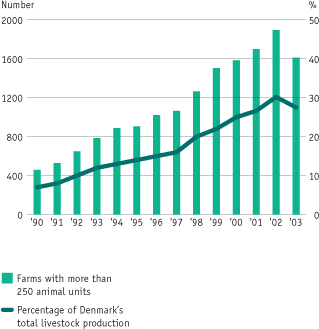
Source: Statistics Denmark
The graph shows the development in the number of farms with more than 250 animal units between 1990 and 2003. The number of animals per animal unit depends on the species. For example, one animal unit is equivalent to one dairy cow or 36 pigs. Thus a piggery with 250 animal units would have 9,000 pigs.
The trend toward large-scale operation is seen most evidently in agriculture where the number of large farms with more than 250 animal units has more than quadrupled since 1990. In 2002, the number of large livestock farms reached 1,896, of which 1,302 were piggeries. In 2003 we see a drop in the number of large livestock farms. A likely reason for this drop is the overall structural development within agriculture leading to fewer but ever larger farms. Apparently, this trend is now also evident for the already-large farms in livestock farming (more than 250 animal units). However, it is still too soon to draw any final conclusions on the basis of a drop in numbers in one year. The large livestock farms today account for one quarter of Denmark's total livestock production.
In some cases, livestock farming causes odour nuisances when located too close to houses and villages. Therefore the distance requirements for livestock farming were tightened in 2004. Emissions of ammonia from livestock farms pose another problem, leading to acidification and over-fertilisation of natural areas. Most natural areas have already reached their critical load. The deposition of ammonia may be very large especially close to the livestock farm. This leads to local problems with deposition of nutrients e.g. in West Jutland where vulnerable heath land depends on nutrient-poor growth conditions.
The political agreement on Action Plan for the Aquatic Environment III calls for the establishment of protection zones around especially vulnerable areas. This protection or buffer zone will be 300 m wide and will be established around all raised bogs, all lobelia lakes (lime and nutrient-poor lakes and ponds/waterholes), and principally all threatened heaths, dry grasslands and other especially vulnerable habitat types in Natura 2000 sites. Within these buffer zones there can be no livestock farm expansions that will lead to increased emissions of ammonia.
When manure and slurry is spread on fields, nitrogen and phosphorous are added. If more nitrogen is added than is absorbed by plants or stored and converted in the soil, nitrogen will be washed out and damage the aquatic environment. Too heavy nutrient loads can lead to oxygen depletion in fjords and the sea. Therefore, there must be a balance between manure production and farmland area. Rules for this are laid out in the harmony requirement in the Danish Statutory Order on Manure. From 1990 to 2003 an average of about 88,000 tonnes nitrogen and about 3,300 tonnes phosphorous were added annually to Danish farmland.
Since adoption of the first action plan for the aquatic environment in 1987, great efforts to reduce leaching and runoff of nutrients have been made, and, today, animal manure is being exploited far more optimally than previously, so that the demand for commercial fertiliser has been reduced.
5 THE OPEN COUNTRYSIDE
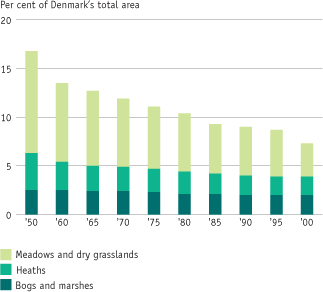
Source: Danish Forest and Nature Agency
The graph shows the area development for meadows and dry grasslands, heaths, and marshes from 1950 to 2000.
The area of the three types of natural habitat has fallen dramatically over the past 100 years. This is because the open countryside and semi-natural areas have long since lost their financial significance and today exist on only 9 per cent of the land. The dunes along the west coast of Denmark are largely used as summerhouse areas, while the heaths and marshes in many other places have been converted to agricultural use or forests. Meadows and dry grasslands, the previously common areas around villages, are now rarely used for grazing and hay. Instead they are becoming overgrown with herbs and scrub. Overgrowing, together with draining and over fertilising pose the greatest threats to the rich biological diversity in meadows and dry grasslands.
6 THE AREA OF DECIDUOUS TREES
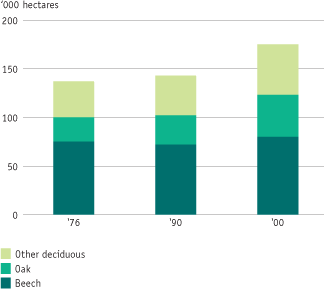
Source: Statistics Denmark
The graph shows the area of deciduous trees in 1976, 1990 and in 2000, broken down into beech, oak, and other deciduous. The total area of deciduous forest has increased over the period.
The area of Danish forests is increasing, and between 1990 and 2000 the increase has been relatively greater for deciduous trees than for conifers. The total forest area in 2000 was 468,000 hectares, of which 293,000 hectares were coniferous forest, and 175,000 hectares deciduous.
Both private and stateowned forests are working with the transition to near-nature forestry. In particular, it is hoped to increase the area of deciduous forest. From 1990-1999 about 70,000 hectares of forest in Denmark were regenerated, and deciduous trees were used on approximately 25,000 hectares of this area, while coniferous trees were used on 45,000 hectares.

7 THE AREA OF CONIFEROUS TREES
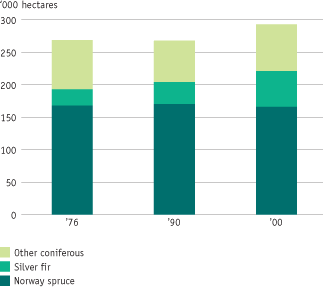
Source: Danish Forest and Nature Agency
The graph shows the changes in the total area of coniferous trees in Denmark broken down into Norway spruce, silver fir, and other coniferous trees.
During the 1990s, the area of forests increased by five per cent. Almost half of the increase arose because of Christmas
tree and decorative greenery cultivation on old agricultural land. The area with Christmas trees and decorative greenery now makes up some 35,000 hectares, and the majority of the pesticides used in
forestry are applied here. Many areas planted with Christmas trees are on former farmland. In 2000 between 10 and 11 million Christmas trees were produced.
The windfalls in 1999 resulting from the powerful storm that struck Denmark in December 1999 have changed the Danish forests.
90 per cent of the overturned trees were conifers, and to a large extent these are being replaced by deciduous trees. Mixed forests can better withstand storms than conifer plantations, and they are habitats for more animals and plants.
8 AFFORESATION
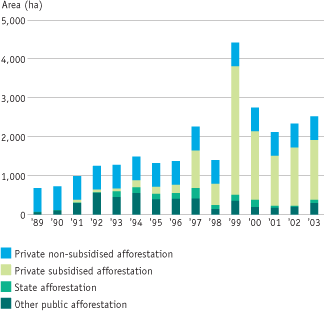
Source: National Environmental Research Institute (NERI), Miljøtilstandsrapport 2005 (The State of the Environment in Denmark 2005); based on data from Danish Forest and Nature Agency
The Danish Parliament decided in 1989 to double Denmark's area of forest within the next 80 to 100 years, corresponding to one tree generation. Afforestation is carried out by state efforts in state forests and by subsidised private efforts. If the goal is to be met, an average of 4-5,000 hectares of trees must be planted each year, which up trough the 1990s would have meant a total of about 45,000 hectares. About half of this area was planted in this period, and only in one year (1999) was the target met.
The new forests mainly have deciduous cover. This is a consequence of increased subsidies for planting deciduous trees, and the requirement for small afforestation projects to include deciduous trees. The state windfall scheme from 2000, which supports replanting of trees felled by the storm in 1999, promotes afforestation of areas with indigenous species more resilient than those lost to windfall and which may develop into forests with greater biodiversity. The damage following the storm in 1999 was as extensive as it was because large parts of Danish forests consist of old stands of Norway spruce, which is not particularly resilient to high wind gusts.

Nature conservation
Several international agreements have been made to protect nature and ensure the masses of plant and animal species. The agreements obligate Member States to protect vulnerable natural habitats, providing the flora and fauna favourable growth and habitat conditions.
International provisions
Denmark has committed itself internationally to strengthening efforts to safeguard biodiversity through the international agreements we have entered into, including the 1992 UN Convention on Biological Diversity, and through cooperation within the EU. The overall objective to stop the loss of biodiversity by 2010 is included in a number of the international efforts which Denmark is part of. This objective makes up the framework for nature conservation, nationally as well as internationally.
The UN Convention on Biological Diversity
The objective of the Convention on Biological Diversity is not only to protect biodiversity, but also to ensure that nature's resources are utilised in a sustainable manner and to secure a fair division of the benefits from genetic resources. In this manner the Convention combines the preservation of nature with consideration of development and reaches far further than previous nature protection conventions that have focused on particularly threatened species or habitats.
At the Biodiversity Convention's sixth Conference of the Parties in 2002, a strategic plan was adopted to achieve the overall objective of a significant reduction in the loss of biodiversity before 2010.
The plan included these four strategic goals:
- The Convention is fulfilling its leadership role in international biodiversity issues.
- Parties have improved financial, human, scientific, technical, and technological capacity to implement the Convention.
- National biodiversity strategies and action plans and the integration of biodiversity concerns into relevant sectors serve as an effective framework for the implementation of the objectives of the Convention.
There is a better understanding of the importance of biodiversity and of the Convention, and this has led to broader engagement across society in implementation.
Biodiversity in the EU - Natura 2000
The EU has an overall goal of halting the loss of biodiversity by 2010. An important instrument in this respect is the establishment of the Natura 2000 network of bird protection and habitats sites. Natura 2000 Sites will form an ecological network of protected natural habitats throughout the EU.
Natura 2000, thus, is the collective term for Special Protection Areas (SPAs) and Special Areas of Conservation (SACs).
- SPAs have been designated in an effort to preserve populations of rare breeding birds or large concentrations of migrating birds. They include Ramsar sites, i.e. wetlands of special importance for birds.
- SACs have been designated to preserve populations of rare animals and plants as well as different types of natural habitat.
The Directives contain two main principles for conserving Europe's nature:
- Member States have to designate, conserve, and manage special protection areas which hold nature types or serve as habitats for species which have been declared protection worthy at Community level.
- Member States have to conserve specified species against collection, extermination, exploitation etc, as well as ensure their breeding sites and resting places against damage or destruction.
Member States have thus committed themselves to managing these areas so as to ensure that species and habitats are given favourable conservation status.
Danish species and habitats covered by Natura 2000
Almost 60 different types of Danish habitat are covered by Natura 2000, such as white dunes and wandering dunes, beech woods and coastal meadows.
Natura 2000 provisions apply to plant, mammal, bird, reptilian, amphibian, fish, and invertebrate species in Denmark. The species of mammal included in Natura 2000 in Denmark are listed below:
- Birch mouse
- Bat
- Grey seal
- Common dormouse
- Whale
- Common porpoise
- Otter
- Pine marten
- Common seal
Source: Danish Forest and Nature Agency

Water Framework Directive
The Water Framework Directive will be at the heart of EU water policy in the decade to come. The Directive will be the general framework for conserving watercourses and lakes, transitional water bodies (estuaries, lagoons/fjords etc.), coastal water and groundwater. The Directive defines a number of environmental targets to be met within a set deadline. Furthermore, it sets out an overall framework for administrative structure, planning and implementation of measures, and for monitoring of the aquatic environment. Filling in the details of the framework is to a large extent up to the individual Member States.
The EU Water Framework Directive entered into force on 22 December 2000. In December 2003, the Danish Parliament adopted a new Environmental Targets Act implementing the Directive in Danish legislation. The Environmental Targets Act (Lov om Miljømål etc.) testifies to the decision by the Danish Ministry of the Environment to combine the implementation of the Water Framework Directive with the implementation of parts of the Birds and Habitats Directives (conservation of certain types of habitat, wildlife and plant).
Actual implantation of the Water Framework Directive,
i.e. commencing steps to meet the environmental targets set out by the Directive, will be over a number of years. When defining targets, the entire water cycle must be taken into account. For instance, the
impacts on surface water in watercourses and lakes should not prevent compliance with the environmental targets set for groundwater.
Source: Danish EPA
Areas in Denmark protected internationally
Internationally protected nature areas in Denmark comprise:
- 254 habitats (SACs)
- 113 bird protection areas (SPAs)
The areas cover 8.3 per cent or 3,591 km2 of Danish land and 12 per cent or 13,047 km2 of Danish seas. They comprise the majority of the most important natural areas in Denmark.
The areas are today protected by comprehensive Danish environmental protection legislation, including special guidelines for management of the areas. Denmark is to safeguard or restore a favourable conservation status for the species and natural habitat types characteristic of the areas designated. In many cases, this requires action. Therefore, new regulation has been prepared which requires the adoption of binding management plans for each area effective from 2009, the so-called Natura 2000 plans. The plans will involve a survey and assessment of status and threats, nature quality targets, and an initiatives plan.
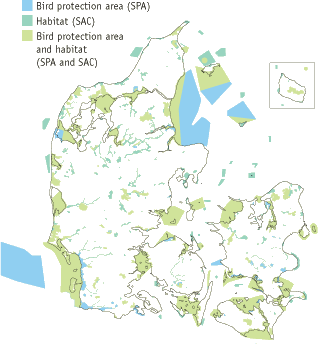
Source: National Environmental Research Institute (NERI) after: Danish Forest and Nature Agency's nature and forest figures for 2003
Habitats and Birds Directives implementation
In 2004, the European Commission approved Denmark's designation of Natura 2000 sites. These include a total of 254 habitats and a total of 113 bird protection areas on land and at sea.
These areas today are protected by comprehensive Danish nature-conservation and environmental-protection legislation supplemented by special management guidelines e.g. in the Ministry of the Environment's statutory order on management of internationally protected areas (including guidelines). The Danish Protection of Nature Act and in particular the general provisions of section 3 are the legal foundation for conservation of land areas in Denmark. This Act is supplemented by several regulations pertaining to area use in a number of other acts dealing with watercourses, forests, spatial planning, environmental protection, etc., as well as in specific instruments pertaining to listing of protected areas, wildlife reserves, nature management, etc.
The Habitats Directive has been implemented in Danish legislation in a process where legislation and practice have been adjusted continuously as the scope of the Directive is clarified e.g. in the European Court of Justice. Thus, in the 2003-2004 Parliamentary year, further amendments were made to the Danish Protection of Nature Act and the Danish Forest Act, and new tools were prepared e.g. for planning and intervention in particularly urgent cases where Denmark's EU commitments are involved.
In December 2003, the Danish Parliament adopted the Environmental Targets Act (Lov om Miljømål etc.) setting out more detailed planning-related guidelines for establishment, with effect from 2009, of actions plans for the aquatic environment and Natura 2000 as the collective basis for active management of the Water Framework Directive and the Natura 2000 Directives.
Natura 2000 planning under the Environmental Targets Act includes:
- carrying out a basis analysis
- setting out targets for the state of the individual site
- establishing an initiatives programme.
The purpose of the basis analysis is to establish a factual basis for specific prioritisation of management efforts, so as to document whether initiatives paramount to complying with the Habitats and Birds Directives are being launched as required. Continuous improvement of the knowledge base for Natura 2000 natural habitats, species, and their development will also be ensured via Denmark's national nature monitoring programme 2004-09, called NOVANA.
Thus, the basis analysis will be the foundation for target setting in relation to the designated areas, including balancing possible conflicting nature interests. Furthermore, it will serve as the basis for national prioritising of areas and initiatives.
In 2003, the National Environmental Research Institute published a technical report on criteria for favourable conservation status, which considers a number of technical parameters to be used when assessing whether the state of Natura 2000 sites and species is satisfactory or needs supplementary efforts. The development of these technical criteria is therefore an important contribution to future Natura 2000 planning, including the introduction of targets for favourable conservation status and initiatives planning.
By 2009 binding management plans will be available for each Natura 2000 site. These plans will contain a survey and assessment of status and threats, nature quality targets, and an initiatives plan. Natura 2000 plans will be coordinated with similar plans for water bodies in the Water Framework Directive.
Member States have committed themselves to administrating the areas with a view to ensuring that species and habitats are given favourable conservation status. This commitment pervades Danish initiatives regarding biodiversity in the years to come.
Other national nature conservation efforts
In 2003, the Government prepared an action plan for biodiversity conservation to ensure that Denmark is meeting the requirements and expectations outlined in the UN Convention on Biological Diversity and nature conservation requirements in the EU. Efforts include e.g. safeguarding existing natural areas of high quality and developing a network of protected natural habitats (the NATURA 2000 network in accordance with the Habitats Directive). Moreover, activities within agriculture, forestry, fisheries, and other sectors will be on sustainable basis.
The action plan is based on further development of wellproven activities (e.g. on initiatives in the three generations of action plans for the aquatic environment) but also introduce new approaches. It is a framework plan for the overall initiatives the Government will instigate in order to safeguard biodiversity and preserve nature. It will not stand alone, but will be accompanied by other nature and environmental initiatives, for example those mentioned in the following.
Denmark's national legislation contains essential administrative tools for the conservation and restoration of biodiversity. Recently, important amendments have been made to the Danish Protection of Nature Act and the Danish Forest Act to ensure better protection of nature and forests. Currently, freshwater and coastal meadows, marshes, heathland, dry grassland, and lakes (open-land habitats) are protected against further decline in area by section 3 of the Danish Protection of Nature Act.
Denmark has launched seven national park pilot projects as a step towards halting the loss of biodiversity before 2010. These pilot projects will be completed with a report in 2005. The report will describe visions, contents, and limitations of possible national parks in Denmark. Nature, outdoor recreation, and historical-cultural environments, as well as socio-economic and business economic consequences will be surveyed and clarified (see textbox on page 17).
In the period 2005 to 2008, DKK 200 million (EUR 26.8 million) have been allocated for use in extra nature protection efforts. The money will be spent on watercourses, river valleys, lakes, coastal
meadows, raised bogs, city-fringe natural habitats, and paths. Efforts will enable initiatives in international nature protection areas and will be an extension
of earlier nature management initiates to conserve existing nature and establish new nature where feasible and beneficial.
The Environmental Targets Act (Lov om Miljømål etc.) adopted in 2003 coordinates efforts within water and nature planning with a view to establishing greater correspondence between the quality of nature and Danish water resources. The purpose is to honour Denmark's commitments under the EU Habitats and Water Framework Directives. Amendments to the Danish Protection of Nature Act and the Danish Forest Act were adopted in 2004. Their aim is to provide for better protection of Natura 2000 sites and establish the tools necessary to carry out the Natura 2000 plans.
Action Plan for the Aquatic Environment III, launched by the Government in April 2004, will continue developments set in motion by the first two plans. The aquatic environment will be further improved through reductions in the discharges of nitrogen and phosphorus, and nature conservation regards will be maintained via e.g. the establishment of spray-free buffer zones along lakes and watercourses. In addition, 300-meter protection zones will be established around the most important natural habitats where there can be no expansion or new establishment of livestock production.
Spatial planning by counties and municipalities constitutes an important tool in the conservation and restoration of biodiversity. Nature planning will be given a boost to make it a suitable prioritisation tool in the conservation and restoration of nature. One major challenge will be to carry on work by local and regional authorities after implementation of the municipality structural reform in 2007 under which the new municipalities will have responsibility for day-to-day management of the Government's nature and environment policies.
A new combined water and nature monitoring programme 2004-2009 (NOVANA) has been set up and it will contribute to and work together with other water and nature planning in response to the Water Framework and Natura 2000 Directives.
The Government will design new, specific initiatives for the conservation of a series of priority natural habitats, such as nutrient-poor heathland, ponds and water meadows, dry grassland, and clear-water lakes. Furthermore, management plans will be prepared for special and rare species, and species towards which Denmark is especially committed.
National parks in Denmark
There is little space for nature in a small, densely populated country like Denmark. Therefore, the Government has launched pilot projects on the establishment of national parks in sites across the country where the natural environment has special significance.
National parks may provide wildlife and plants with large coherent areas in which to thrive. Similarly, people are allowed greater opportunity for enjoying and experiencing the beautiful and characteristically Danish landscape and wildlife.
The pilot projects will collect experience on how to best establish national parks with local involvement, and how to balance nature and wildlife concerns with those of tourism and industry.
There are seven pilot areas:
• Lille Vildmose
• Læsø
• Mols Bjerge
• Møn
• Kongernes Nordsjælland
• Thy
• The Wadden Sea
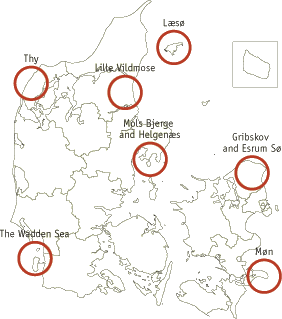
Source: Danish Forest and Nature Agency
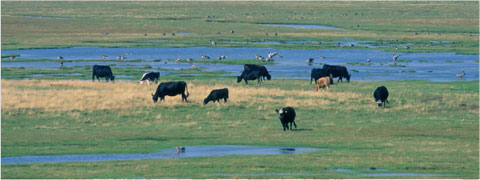
Protected natural habitat types
The protected open-land habitat types (dune, heathland, coastal meadow, freshwater meadow, dry grassland, and marsh) were most widespread in Denmark 200 years ago when they covered up to 60 per cent of the country. Today, however, these habitats cover less than 9 per cent of Denmark. Regional distribution of the habitat types shows that heathland is most common on the sandy and nutrient-poor soil in West Jutland, whereas on the more fertile moraine soil in East Jutland and on Funen and Zealand dry grassland is the predominant habitat type. Open-land natural habitat types are today protected against further decline in area by section 3 of the Danish Protection of Nature Act. Almost 50 per cent of the areas have moreover been designated as Natura 2000 sites providing them double protection; a fact visible in the table below. Historically, the decline in area of open-land habitat types has been accompanied by fragmentation and general reduction of natural areas in Denmark.
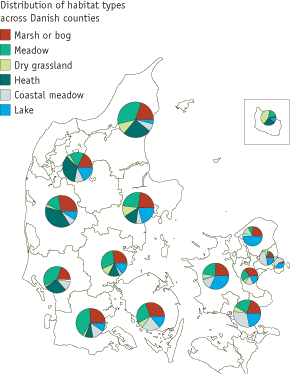
Source: National Environmental Research Institute (NERI), Miljøtilstandsrapport 2005 (The State of the Environment in Denmark 2005)
| Open-land natural habitat type |
Area (ha) | % of Denmark's land area |
% situated in Natura 2000 habitat sites |
| Dry grassland | 25,986 | 0.6 | 23.6 |
| Heathland | 82,013 | 1.9 | 49.7 |
| Freshwater meadows | 103,722 | 2.4 | 56.1 |
| Marshes | 89,919 | 2.1 | 32.6 |
| Coastal meadows | 43,622 | 1.0 | 76.4 |
| Dunes (estimated) | 30,000 | 0.7 | - |
| Total | 375,262 | 8.7 | 47.2 |
9 NATIONALLY PROTECTED AREAS
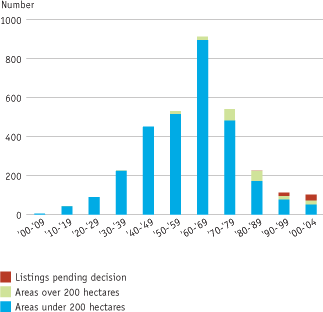
Source: Danish Forest and Nature Agency
The graph shows the number of areas entered on the National List of Protected Areas in the period 1900 to 2004: a total of 5034 protected areas. These do not include the around 1,100 protected areas near old churches, the so-called Provst-Exner listings. Until 1999, the protected areas are divided in time intervals of a decade's length. The graph shows when the areas were formally entered on the National List of Protected Areas. Typically, from it is initialised till it is finalised a listing takes between 2 and 10 years. The graph shows the number of protected areas under 200 hectares and the number of large areas of over 200 hectares. Overall, 4 to 5 per cent of Denmark's land area is protected.
The purpose of entering areas on the National List of Protected Areas is to safeguard valuable landscapes and valuable natural and historical-cultural areas. It is applied when the relevant areas cannot be protected through other legislation. The graph shows that the number of areas entered on the Natinal List of Protected Areas gained speed in 1920 when work to protect nature became organised. This was after adoption of Denmark's first Nature Protection Act in 1917. At the centre of efforts were characteristic geological formations and beautiful vistas. In the following decades, protection efforts broadened their aim and the number of areas entered on the National List of Protected Areas increased up through the 1930s and 40s. In the period 1940 to 70, the number of listings finalised rose dramatically. Listing of protected areas was then used as a means of stopping the building boom in the open countryside of summer and year-round residences, as well as a dramatic rise in raw material extraction of e.g. gravel, sand, clay, and chalk. The number of listings, however, has fallen in the period 1980 to 2005, partly because protection interests have been secured gradually through other landuse, sector, and spatial planning legislation, and partly because the most valuable areas have already been entered on the National List of Protected Areas.
The graph seems to point to the fact that planning and general protection efforts under other legislation have gained momentum as a key instrument in nature protection work. Despite the many listings, however, there is still a need to carry out a not insignificant number of listings and other protection means of Denmark's natural and historical-cultural environments. New protection needs arise continually as a consequence of developments in society, and they cannot be met under other land-use legislation. Furthermore, since the 1992 Protection of Nature Act, a number of cases regarding nature restoration have been raised.
10 AREAS ACQUIRED BY THE STATE FOR NATURE MANAGEMENT
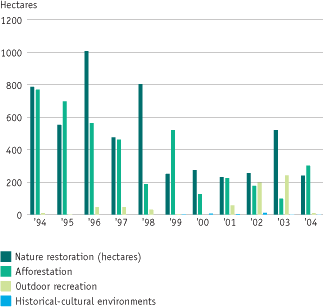
Source: Danish Forest and Nature Agency
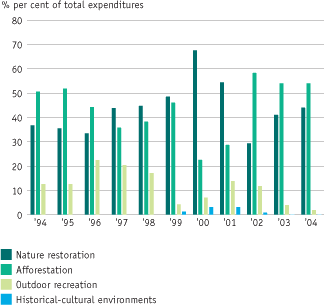
Source: Danish Forest and Nature Agency
The figures illustrate efforts to preserve and restore habitats for indigenous species of plants and animals. The figures provide an overview of the annual efforts made with funding from state nature management funds. The topmost figure shows the extent of the areas acquired by the state for nature management, measured in hectares. The area acquired per year, measured in hectares, is evidence of the physical efforts made and their relative distribution within the areas nature restoration, afforestation, outdoor recreation, and historical-cultural environments. Improvements favouring outdoor recreation and historical-cultural considerations are often incorporated in state nature restoration and afforestation programmes. The bottommost figure illustrates the prioritisation of the action areas within state nature management divided into nature restoration, afforestation, outdoor recreation, and historical-cultural environments measured in per cent of the total funds allocated for nature management.
Up until 1998, the aim was to spend 40 per cent of these funds on nature restoration, 40 per cent on afforestation, and 20 per cent on outdoor recreation. After 1998, the aim has been to distribute the funds as follows: 40 per cent on nature restoration, 30 per cent on afforestation, 20 per cent on outdoor recreation, and 10 per cent on historical-cultural environments. From 2002, in principle, historical-cultural environment has been discontinued as an independent project criterion.
Deviations can be made from this distribution in connection with relevant projects and changes in the annual allocations of funds. From 1999-2001, a significant part of the annual funds were earmarked for
the Skjern River Project, which means that nature restoration accounts for a high percentage of the total annual expenditure in this period. In 2002, there was co-funding from e.g. public waterworks and
municipalities earmarked for afforestation,
so that more nature management funds were channelled to afforestation in that year. The level of acquisitions of areas for nature restoration and afforestation has fallen since 1998. This is partly due to the fact
that a significant number of the annual nature management funds as mentioned were earmarked for the Skjern River Project dur
ing the period 1999 to 2001. Furthermore, some of the land bought in 2002 and 2003 for the purpose of afforestation included buildings making the price per hectare considerably higher than in previous
years.
The nature restoration projects help fulfil international obligations, e.g. in connection with the EU Bird and Habitats Directives, and the UN Convention on Biological Diversity. Afforestation supports national political goals and helps, in particular, to protect vulnerable groundwater resources which are used as drinking water supply, and contributes to the establishment of recreational areas close to urban areas - often in cooperation with waterworks and municipalities.

Conservation and restoration of coastal dune heaths
Coastal dune heaths are rare in Europe. In Denmark, however, this habitat type exists in relatively large areas, which Denmark consequently has a special obligation to conserve. Coastal dune heaths are habitat for plants and wildlife that depend on the dynamics of the nearness to the sea. In many places, overgrowing with trees, inadequate grazing, draining, etc. have so changed the dunes that indigenous flora and fauna species are having difficulties surviving. Therefore, nurturing and managing the dune heaths is often necessary to conserve or restore them to more natural conditions.
In the period 2001 to 2005, a nature management project was carried out between the Danish Forest and Nature Agency, the Danish Armed Forces, four counties, and two research institutions, covering more than 6,000 hectares of dunes along Jutland's west coast and on the islands of Fanø, Rømø and Læsø. The project proved to be a valuable push in the right direction for restoration and conservation management of a very large proportion of Denmark's dunes.
The project received EU financing of 60 per cent of project expenditures, around DKK 35 million (EUR 4.7 million) in total. Remaining expenditures were covered by the Danish Forest and Nature Agency and the other partners in the project (the counties of Ribe, South Jutland, North Jutland, and Viborg, as well as the Danish Armed Forces, University of Copenhagen and the National Environmental Research Institute.
Main activities of the project were:
- Dune heaths with mountain pine plantations were cleared
- Overgrown dune heaths with self-planted mountain pine and other non-indigenous trees were cleared
- Natural dynamics were restored as best as possible by burning off small or large areas, by cutting or crushing vegetation, or introducing grazing
- 176 hectares of privately-owned overgrown dune heaths on Rømø were purchased so that the area could be incorporated in cohesive management efforts, mainly clearing
- Breeding sites were restored for amphibian species such as the natterjack toad and sharp-nosed frog
- Drainage ditches were disestablished to restore natural wetlands for flora and fauna
- Information boards and folders were made and placed at 30 particularly interesting sites
- Guided tours were arranged for all those interested
- A three-day seminar was held in the second project year for project participants and others with an interest in dune heaths from all over Europe
- The National Environmental Research Institute and the University of Copenhagen monitored the project and will be evaluating effects in more detail and coming up with recommendations on best conservation of Danish dune heaths.
Source: Danish Forest and Nature Agency
Wildlife and plants
The UN Convention on Biological Diversity obligates Member States to protect nature. Essential in this regard, is the conservation of the habitats of wildlife and plant species. The objective is to halt the decline in biodiversity by 2010.
Denmark is the threshold between the Atlantic region and the continent, between the saline North Sea and the brackish waters of the Baltic Sea, and although Denmark is a small country, our climate is changeable, with considerable regional differences. Therefore, Denmark is the natural home for a large number of plants and animals - around 30,000 species in all.
Red-listed species in Denmark
In 2004, the National Environmental Research Institute updated Denmark's Red List of threatened species, now with a total of 2,465 species of Danish fungi, insects, spiders, birds, etc. The update revealed that one in every four species is evaluated as having disappeared or as being threatened to a greater or lesser extent.
To red list is to evaluate which plant and wildlife species are at risk of extinction. Plant and wildlife species die out (or come into existence) as part of the Earth's natural processes. However, throughout the last century increased human activity has led to greater risk of extinction for certain species.
In the 2004 evaluation, specialists found 678 out of 2,465, or 27 per cent of Denmark's species to have either disappeared or to be threatened to a greater or lesser extent. 66 species have disappeared from Denmark since 1850, whereas 93 are evaluated as critically endangered. A total of 1,455 species are considered free from threat and for the last 196 species data is insufficient to make an evaluation.
The purpose of red listing is partly to provide a basis for assessing developments in natural biodiversity in Denmark, and partly to honour Denmark's international commitments under the UN Convention on Biological Diversity, which Denmark ratified in 1994. Denmark has the following national sub-targets under the UN Convention on Biological Diversity:
- to create awareness about disappeared or threatened species
- to create a foundation for making priorities in nature monitoring in Denmark
- to create a foundation for nature management and nature protection work, nationally and internationally, and
- to fulfil Denmark's international commitments under the UN Convention on Biological Diversity through routine publication of red lists of indigenous, disappeared and threatened species of plants and wildlife in Denmark.
Status of threatened species
| Group | Number of species |
Critically endangered (CR) |
Moderately endangered (EN) |
Vulnerable (VU) |
Number of threatened species |
| Birds | 209 | 6 | 8 | 7 | 46 |
| Reptiles | 8 | 0 | 0 | 0 | 1 |
| Amphibians | 15 | 1 | 0 | 0 | 3 |
| Insects, spiders, etc.: | |||||
| Carabidae | 182 | 3 | 10 | 23 | 62 |
| Odonata | 54 | 2 | 1 | 3 | 17 |
| Lucanidae, Trogidae, Geotrupidae, Scarabaeidae | 92 | 10 | 12 | 4 | 52 |
| Cerambycidae | 73 | 2 | 4 | 9 | 26 |
| Curculionidae, Brachycerinae | 110 | 1 | 3 | 5 | 13 |
| Brentidae | 83 | 5 | 2 | 5 | 15 |
| Lepidoptera: Rhopalocera | 98 | 7 | 10 | 10 | 43 |
| Diptera: Syrphidae | 280 | 4 | 15 | 34 | 82 |
| Diptera: Asilidae | 30 | 5 | 2 | 3 | 13 |
| Orthoptera | 33 | 4 | 0 | 1 | 9 |
| Arachnida: Araneae | 244 | 0 | 3 | 2 | 8 |
| Crustacea: Branchiopoda: Notostraca; | 2 | 0 | 0 | 1 | 1 |
| Heteroptera: Gerromorpha & Nepomorpha | 59 | 0 | 1 | 1 | 3 |
| Tenebrionidae | 45 | 1 | 4 | 3 | 15 |
| Elateridae, Eucnemidae | 76 | 2 | 2 | 9 | 20 |
| Nemonychidae | 1 | 0 | 0 | 0 | 0 |
| Anthribidae | 11 | 0 | 1 | 2 | 3 |
| Attelabidae | 18 | 0 | 0 | 1 | 1 |
| Curculionidae, Curculioninae, Dryophthorinae, Cossoninae | 20 | 0 | 3 | 1 | 7 |
| Curculionidae, Scolytinae | 62 | 0 | 4 | 4 | 10 |
| Crustacea: Branchiopoda: Laevicaudata and Spinicaudata | 1 | 0 | 0 | 0 | 0 |
| Crustacea, Branchiopoda: Anostraca | 2 | 0 | 0 | 0 | 0 |
| Orchids | 46 | 3 | 8 | 7 | 28 |
| Fungi: | |||||
| Clavarioid fungi and Ramarias | 6 | 0 | 0 | 0 | 1 |
| Hydnaceous fungi | 22 | 9 | 6 | 4 | 20 |
| Polypores | 147 | 8 | 16 | 7 | 41 |
| Corticoid fungi | 65 | 0 | 1 | 6 | 8 |
| Agarics | 146 | 13 | 34 | 15 | 77 |
| Russula and Lactarius | 185 | 6 | 20 | 23 | 55 |
| Inoperculate discomycetes | 37 | 0 | 0 | 0 | 0 |
| Hydnaceous, (Hericiales pp. Gomphales pp.) | 5 | 1 | 1 | 1 | 5 |
| Total | 2465 | 93 | 171 | 190 | 454 |
Source: National Environmental Research Institute (NERI)
11 BIRDS IN THE OPEN COUNTRYSIDE
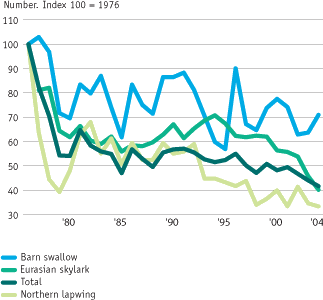
Danish Ornithological Association's bird point source count
The graph shows the changes in the total population of northern lapwing, barn swallow, and Eurasian skylark from 1976 to 2004. The overall development also includes populations of corn bunting and grey partridge.
Since the 1970s, the populations of skylark and lapwing have halved. The primary reason is increased drainage by agriculture and, in general, more intense exploitation of grass areas. The increased use of pesticides by agriculture eradicates the plants and insects that birds living on agricultural land depend on. The Eurasian skylark, Denmark's third most common species of bird, has adapted to the arable land to some extent. The positive, upward trend in population growth of the skylark from the mid 1980s, however, has peaked. This species is now in decline throughout most of Europe, and mostly so in west-European countries.
The breeding population of swallow fluctuates considerably from year to year. These fluctuations depend on e.g. weather conditions during migration and at the birds' winter habitat. In general, the number of breeding birds has fallen by about 25 per cent since the 1970s. This is linked to a fewer number of farms with livestock and poorer access to barns and outhouses, so that it is difficult for the swallows to find suitable nesting sites. The barn swallow is in decline throughout almost all Europe.
For the 20th century as a whole, the great losers were the birds living on meadows and heaths such as the white stork, and black grouse. Black grouse no longer breed in Denmark and nor do white stork. There were 2,000 breeding pairs of white storks at the beginning of the 20th century. Finding food is difficult for this much-loved bird because many of the ponds are gone, and with these the amphibians the stork feeds on. Regarding other rare breeds, the crane is on the increase, while the white-tailed eagle, peregrine falcon, black stork, and eagle owl are all now breeding in Denmark after many years' absence. One of the tools to conserve and re-establish bird populations is to cultivate marginal soil less intensively. In many cases subsidies are available from the EU agricultural support funds for environmentally friendly farming or set-aside.
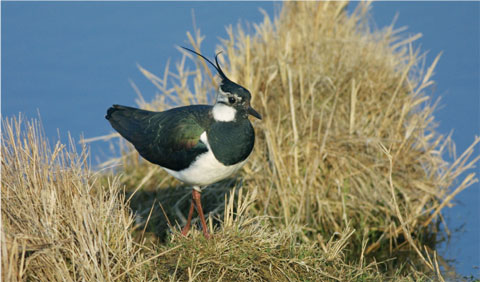
12 POPULATIONS OF WILD FAUNA IN THE OPEN COUNTRYSIDE
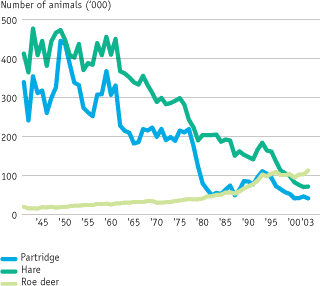
Source: National Environmental Research Institute (NERI)
The graph shows hunting bags of hare, partridge, and roe deer from 1941 to 2003 and serves as an indicator for the development trends for the population of these species in the open countryside.
There have been significant changes for some game on agricultural land over the past 50 years. A considerable increase in bags of roe deer, and corresponding falls in bags of hare and partridge reflects great changes in populations. The population of roe deer has increased because the deer have had perfect breeding conditions over a long period, with access to plentiful food in forests and on cultivated fields. At the same time the climate has been favourable, and since the 1980s, fawns have been less threatened by foxes because of outbreaks of fox scabies in Jutland and on Bornholm. In contrast to the roe deer, populations of hare and partridge have fallen dramatically since 1960. These two species are more dependent on open country than the roe deer, which uses both forests and fields. The reason for the fall in the numbers of hare and partridge can primarily be found in changes in agricultural practices, for example increasing sizes of fields, and more uniform crops, both of which result in less food. With the relatively low numbers, it is also likely that hare and partridge have become more vulnerable to predators such as foxes, crows, and magpies.
One of the goals in the Government's Action Plan for Biodiversity and Nature Conservation in Denmark 2004-2009 is to protect the natural habitats of vulnerable species and stop the deterioration in biological diversity before 2010.
13 BUTTERFLIES
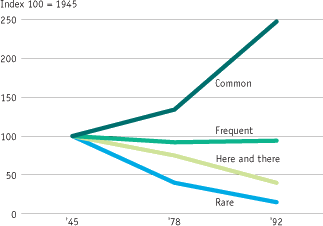
Source: Danish Forest and Nature Agency
The graph shows the distribution of the 79 species of Danish butterfly. The species have been divided into four groups according to how common they were between 1900 and 1963. The most common quarter of species has increased since 1963, while the rarest species have declined.
The fall in the number of rare species is especially due to the disappearance of their habitats. In Denmark, two-thirds of butterflies live in meadows, marshes and dry grassland, and one-half of these species now appear on the Red List of threatened species. Nine species have disappeared over the past 50 years.
Since 1963, the most common butterflies such as the small cabbage white and the small tortoiseshell butterfly, which thrive on thistles and nettles, have increased at the expense of falling numbers of rare species such as the marsh fritillary and ilex hairstreak.
Registration of the number of plant and animal species on the Red List, compared with Danish natural habitats, could help target efforts to preserve and re-establish habitats for native Danish animals and plants with large sustainable populations both on land and in fresh-water and marine environments.

Otter population
The four maps show the occurrence and distribution in 10x10 UTM squares of otter from national monitoring in Denmark in 1984-1986, 1991, 1996, and 2004.
In collaboration with regional authorities, the National Environmental Research Institute in spring 2004 conducted a nation-wide monitoring survey of the otter population in Denmark. The survey was part of the new national nature and aquatic-environment monitoring programme, NOVANA. Nation-wide monitoring surveys of Danish otters were previously carried out in 1984-1986, 1991 and 1996, which provides ample opportunity for comparing the population development over a 20-year period.
Results show that the otter has increased considerably in numbers in Denmark since the mid 1980s. In the mid 1980s, not many otters were observed except in the northern and northwestern parts of Jutland (Ringkjøbing, the counties of North Jutland and Viborg). However, today the population of otter has increased in Aarhus County and the otter is once more present in the counties of Vejle, Ribe, and Southern Jutland where otters can be found near the border to Germany. In West Zealand, where the otter was considered to have disappeared until it was seen again in 1996, two new spottings have confirmed its continued presence in this region.
The positive development in the population of otter can be explained e.g. by targeted conservation efforts in the form of a management plan in 1996 and, later, in connection with the implementation of the EU Habitats Directive. Requirements for preventive grids in fishing nets and the establishment of fauna corridors under new and old roads has led to fewer numbers of otters drowning in fishing nets or being killed on the roads. At the same time, regional authorities are taking the otter into consideration in their management of the open countryside: more and more care is being taken to conserve the otters' natural habitats, establish new habitats through nature restoration, and designate corridors via which the otter can travel undisturbed from place to place.
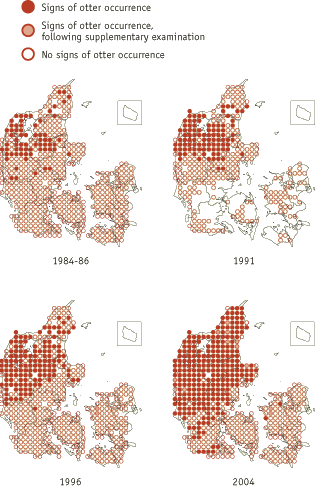
Source: National Environmental Research Institute, NERI
14 MONITORING ORCHIDS
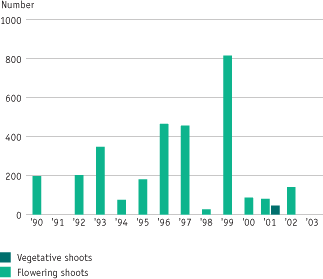
Source: National Environmental Research Institute (NERI), survey of orchids
The figure shows the conservation status for broad-leaved marsh orchid, exemplified via this orchid type's status at Almstofte, a location in the County of West Zealand. The Broad-leaved marsh orchid is found in about 800 locations throughout Denmark, making it the most common wild orchid in Denmark. Considered across all localities, the broad-leaved marsh orchid is in decline.
Monitoring of orchids and their habitats began in 1943 when the state forest district of Buderupholm in North Jutland commenced a count of the region's population of lady's slipper orchids (Cypripedium Calceolus).
Monitoring of other species was commenced in 1982. Since then, all 46 Danish species of orchids in the wild have been monitored for shorter or longer periods of time. Of these, 21, or 46 per cent, are on Denmark's Red List of threatened species. This means that they have either disappeared (3 orchids), or that they are critically endangered (3 orchids), moderately endangered (8 orchids), or vulnerable (7 orchids).
The most common species throughout Denmark are monitored in selected locations, whereas the species that are only common in 10 locations or fewer throughout Denmark are monitored, more or less, in all locations where they are found.
The orchid as a species is protected, which means that the plant may not be damaged or up-rooted; nor may its seeds be collected. Orchids may, however, be enjoyed in nature. Some orchid species place high demands on their habitat and lead a complicated co-existence with certain fungi. Other species can live in various places and are common in most regions of Denmark.
15 SEALS
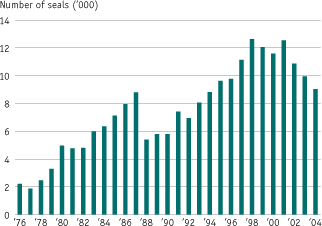
Source: National Environmental Research Institute (NERI)
The graph shows the number of common seal in Danish waters counted from aeroplanes during the period 1976-2004. The figures have been corrected for seals underwater during the count. In some years the population of seal was not counted in all marine areas but estimated or calculated as averages based on figures for the previous and subsequent years.
There are two species of seal permanently resident in Danish waters, the common seal, and the grey seal. The grey seal became protected by statute in 1967, and it is still very rare in Denmark (<50 animals per year). In February 2003, two grey seal young were observed at Rødsand near Gedser. This shows us that the grey seal has begun to breed in Denmark for the first time for more than hundred years.
In 1976, the common seal was protected by statute. After being protected, the population of common seal grew by about 12 per cent per year. In spring 1988, the common seal was hit by the worst mass mortality of sea mammals ever recorded in European waters. Over 18,000 seals were found dead along the northern European coastline (the Netherlands to north Norway), and about 60 per cent of the Danish population died. In 2002, all populations of Danish seal were again hit by the deadly seal virus (PDV) that hit in 1988, and about 45 per cent of the Danish population is thought to have died. In autumn 2004, more than 9,000 common seals and 31 grey seals were observed in Danish waters.
In 2005 the Ministry of the Environment published a management plan for the common seal and the grey seal in Denmark. The objective of the plan is to give the seals the best possible living conditions and to ensure their protection and survival. The plan is also to help implement the Habitats Directive target of ensuring or restoring the favourable conservation status for seals.
16 CATCHES OF FISH IN DANISH WATERS
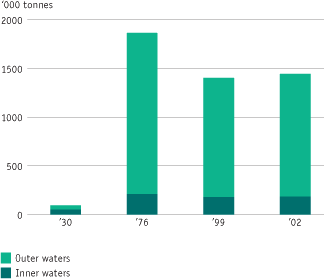
Source: National Environmental Research Institute (NERI)
The bars show Danish catches broken down between those from inner and outer waters in 1930, 1976, 1999, and 2002.
Many commercial fish in Danish waters are being exploited so intensively that half the stock is fished each year. In 2001, the International Council for the Exploration of the Sea (ICES) described a major part of commercial stocks as overfished. This includes cod, plaice, sole, haddock, whiting, pollack, anglerfish, and eel. Catches by Danish fishermen have been in decline since the mid 1970s. Despite this, Danish waters cover some of the world's most important fishing grounds with annual landings from the North Sea, the Skaggerak, Kattegat, and the Baltic Sea of 3.5 million tonnes. Of this amount, Danish fishermen caught 1.5 million tonnes per year in the late 1990s. In recent years, fishing has become more efficient, with fewer and larger vessels.
In 2001, the Danish Parliament adopted some key objectives for the development of a national fisheries policy in the years to come. One objective calls for the modernisation, renewal, and simultaneous reduction of the fisheries fleet. The objective is to ensure long-term, stable and sustainable fisheries in relation to possible catches and continued local fisheries with a wide geographical basis. Within this framework, the national management of fisheries quotas will be adapted. Goals include to develop coastal fishing and to promote the quality of landings.
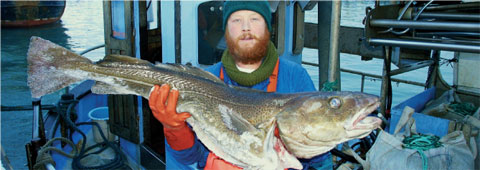
17 INTRODUCED SPECIES AND THEIR DISTRIBUTION
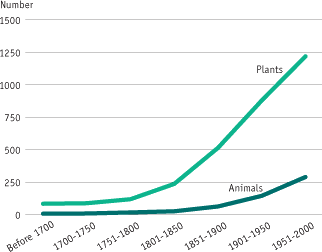
Source: Danish Forest and Nature Agency, and National Environmental Research Institute (NERI)
Plant and animal species that are brought to Denmark, either intentionally or unintentionally are called introduced species. Some of these introduced species may survive in Danish nature and a few are capable of procreating and spreading to a degree that they out-compete or otherwise threaten indigenous species; these are called invasive species. Examples of invasive species in Denmark are giant hogweed, mink, and killer slug (Iberian black slug).
The graph shows the number of animals and plants introduced to Denmark and subsequently found in nature. The species are broken down by time intervals of 50 years length, except, however, the category ”before 1700”. The total number of introduced species in the present statement is more than 2,570. For 1,534 of the species, we know the time of introduction (presented in the figure). About 600 species have adapted to the Danish environment, i.e. become naturalised. For animals, the annual introduction rate has increased in the most recent time interval, whereas the introduction rate for plants appears to be relatively constant. About four-times more plants than animals have been introduced.
The majority of introduced species cause no or few problems, however a few have spread with great speed and threaten to out-compete other species. These invasive species pose
a problem in nature, which is gaining ever more attention. They invade natural areas, gardens, and parks, they may spread diseases, and combating them is a costly and difficult affair. Ground elder, wild
oat-grass, and brown rat are examples of invasive species, which we are spending many resource combating.
The problem has been recognised internationally as extensive and as a global threat against biodiversity surpassed only by the destruction of natural habitats. Therefore, the UN Convention of Biological Diversity contains a common international commitment to limit the introduction and negative effects of invasive species.
Intended introduction also includes species that are introduced in a new country as e.g. ornamental plants or pets, and which then are spread or escape and establish themselves in nature. The intended introduction of huntable or fishable species also contributes to introduction of new species in the wild in Denmark. Non-indigenous animals may not be released into nature without permission, whether pets (such as turtles) or fish and animals for use in hunting or as part of nature management efforts. Unintended introduction is e.g. when a species is carried to Denmark as a stowaway along with goods, attached e.g. to cars, trains, or clothes, in which way they spread quickly across borders and continents.
With regard to the marine environment, ballast water, algal and marine growth on ships, and aquaculture activities, i.e. farming of freshwater or saltwater fish, are the most prevalent introduction routes for new species. Ships' ballast water may even serve to introduce species that survive in freshwaters.
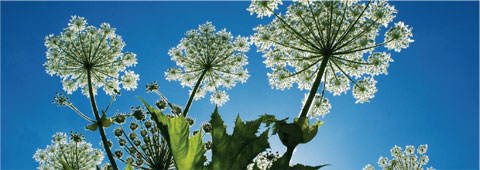
Climate change
Our global climate is warming up. The average temperature has gone up by 0.6 degrees Celsius during the 20th century, and 1990-2000 was the warmest decade ever measured. Nature has started to respond to these changes. Trees are blossoming earlier during the season, animals are migrating, and sea levels are rising.
Global warming
Over the last 10 to 20 years an increasing number of observations worldwide have delivered evidence that our global climate is changing markedly. The temperature is increasing, precipitation quantities and patterns are changing, and extreme weather with flooding and storms is becoming more frequent (Intergovernmental Panel on Climate Change (IPCC) 2001).
Since pre-industrial time, a warming of the Earth's surface by
0.7 °C has been observed; a trend which is unusual compared to the scope and speed of natural climate variations observed within the last 1000 years. Globally, the 1990s were the warmest decade ever
registered since records began in 1870, and, in Denmark, the temperature has risen by 1 degree since 1870. 1990 and 2000 were the two warmest years ever measured in Denmark. Globally, 1998 was
documented as the warmest year, with 2002 and 2003 following in step.
The magnitude and speed of changes in climate in future is still uncertain. It depends on how well we succeed in limiting the global emission of greenhouse gases. Moving from observations backwards in time to future scenarios toward the year 2100, our conclusions become increasingly hypothetical and have to be based on ever more complicated model calculations.
However, today it is commonly accepted that climate change caused by humans has consequences for virtually all of the Earth's ecosystems; the world's food production; the accessibility, quantity, and distribution of freshwater around the globe; human health; and the foundation for social development and economic growth in many countries. Thus, the global warming which has taken place over the past 20 to 30 years is already measurable in the distribution and population frequency of many plant and animal species. In Europe, it has been observed that plant species are spreading northward as a consequence of the increased temperatures. Thus, climate change increases the pressure on ecosystem functions and on valuable nature assets.
18 POLLEN-SEASON ON-SET AND QUANTITIES
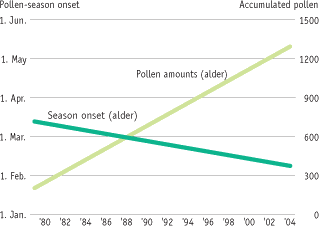
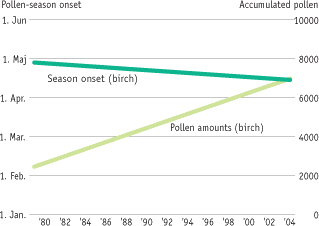
Source: Danish Meteorological Institute (DMI)
The graph shows the effects of climate change in Denmark, expressed by the beginning of the pollen season and pollen quantities (development trend). It appears that the pollen season has changed significantly since pollen counts began in 1977. The season starts earlier, and the quantities of pollen have increased. The greatest change in terms of the beginning of the season concerns early pollen from alder, from around 12 March to 19 February. The change for birch is somewhat more modest - from around 23 April to 17 April.
The reason for this shift towards earlier pollen seasons is that the weather, especially in the spring months, has been significantly warmer in recent years than when pollen counts began. Annual pollen quantities (the sum of the daily pollen counts) have increased significantly - generally speaking by a factor of 2 to 3 during the period. The general increase can be one explanation for the observed increase in the number of people allergic to pollen.
The greater quantities of pollen may be partly due to the increase in temperatures during the period, as higher temperatures usually lead to better growth conditions.
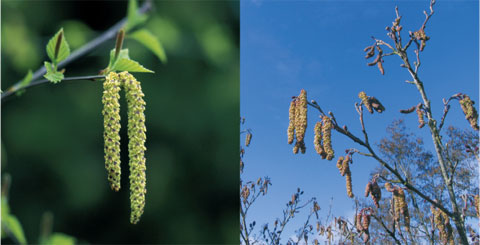
Climate change in Denmark - examples of impacts on nature
The Danish climate is getting warmer and in future we can expect a warmer, more humid and windier climate with more storms and more frequent periods with precipitation. The mean temperature in Denmark is now about 8°C; an increase of 1 degree since 1870. During the last century, annual precipitation has gone up by 110 mm to around 750 mm (Danish Meteorological Institute (DMI) 2003).
For a number of the IPCC's emission scenarios, Denmark's Climate Center under DMI has calculated the expected changes in Denmark's climate over the next century. For Denmark, the development toward 2100 shows an increase in annual precipitation of 10 to 20 per cent, most markedly in the winter season, and, thus, showing a clear trend toward a wetter winter climate. For the summer season, the trend is toward longer periods without precipitation and, thus, toward increased risk of droughts. The annual average temperature will be 3 to 5 °C higher than today; an increase which will apply equally for summer and winter, however with greater increases in night temperatures.
Wind conditions will also change. Westerly winds will prevail more frequently in future. At the same time, there will be a moderate risk of increased storm activity over Denmark and adjacent waters, both with regard to frequency and intensity.
If the temperature increases by 3 degrees, the natural northern limit for many plant and animal species' natural habitats will move 300 to 400 km to the north. Many species will have difficulties reacting to the fast changes by moving (migration) or by adjusting physically to the changes in conditions (genetic adaptation).
Coastal areas
The Danish coastline has a total length of about 7,300 km. How many kilometres are threatened by storm flooding or by increased water levels and storm activity in general is uncertain. Roughly speaking, the vulnerable areas are those parts of the country which, geologically, consist of raised, former seabed with Stone-Age and marsh sedimentations (approximately 4,300 km²), as well as dammed-in areas which are secured by dikes. Some dikes protect urban areas, e.g. the marine dikes in the Wadden Sea outside the cities of Ribe and Tønder, others primarily protect farmland, recreational areas with or without buildings, or coastal wetlands such as the Wadden Sea.
The marine environment
According to DMI's projections of climate in Denmark, sea temperatures in the seas around Denmark will increase by 3 to 5°C in the years toward 2100. An expected increase in sea temperatures will prolong the growth season of marine phytoplankton, and it will increase the marine ecosystem's general productivity, which means it will also increase the catch potential for fisheries. An increased water temperature in the North Sea will also entail the northward migration of southern species. This phenomenon has been observed already for benthic animals around the British Isles over the past 50 years, during which the ratio between warm-water and coldwater species within the group of zooplankton has shifted. In Danish marine waters, species such as mullet and rockfish are being observed more and more frequently, although these species normally prefer a warmer climate.
Forests
Increased storm activity, including more frequent storms and more severe storms, will be one of the negative consequences of a changing climate. It will mean greater risk of windfalls in Danish forests. As the 1999 storm evidences, the storm damage may be extensive. This is because a great part of the Danish forest cover is old stands of Norway spruce; a tree species not particularly resilient to high wind speeds. Denmark is placed centrally in a vegetation belt of temperate deciduous forest. In the case of moderate, future climate change, a majority of existing tree species will be able to persist in Denmark. Norway spruce, however, may be the exception. Norway spruce is naturally occurring in regions with cold winters and the species has already shown signs of poorer health in periods with warmer winters. According to a forest inventory in 2000, Norway spruce makes up about 27 per cent of the forest cover in Denmark. Moreover, in terms of area it is the most important tree species in forestry in Denmark.
In several European countries forests have been observed to be growing at a faster rate than previously. The marginal growth increment of individual tree species has increased considerably due to increased CO2 in the atmosphere and longer growth seasons, and also due to increased depositions of nitrogen and more intensive forestry. The expected climate change will enhance growth, particularly of those species which have their northern tree line in southern Scandinavia. Advantages for these species may, however, be limited by less precipitation during summer and increased risk of drought.
Plants and wildlife
The warming of our climate over the past 20 to 30 years has influenced the distribution and number of many plant and wildlife species across the globe. In Europe, many plant species have been observed further north than their original habitat due to rising temperatures (EEA 2004). Monitoring of the flowering season of plants in botanical gardens throughout Europe has shown that the growth season has increased by 10 days from 1962 to 1995.
In Denmark, the growth season, i.e. the period from leafing foliation to leaf drop, has been prolonged by 2 to 3 weeks and is expected to increase further. A longer growth season will increase plants' growth and productivity for species where the temperature is a constricting factor, and will lead to changes in the competition parameters and species distribution within natural ecosystems.
A warmer climate in Denmark will make it possible for southern plant and wildlife species to immigrate. The extent to which this may take place in practice depends on the barriers such species will meet in the form of farmed fields, urban areas and road infrastructure - barriers which are fairly easy to overcome for plant species whose seed spread via the air, or plant species that spread in ditches along roads. An example of the latter is wood-small reed, which is a southerly species now growing more and more commonly in Denmark. Indigenous species which have their natural southern habitat line in southern Denmark might disappear altogether because they are not strong enough to withstand the competition. One such plant species naturally belonging in the north is dwarf cornel.

The distribution of Norway spruce
Norway spruce requires cold winters and its natural habitat roughly follows a temperature line for January of -2°C. If the temperature rises e.g. by 4°C, the tree line for Norway spruce might move to the present -6°C line. Note that Denmark is already outside the present natural area of growth for Norway spruce.
(According to: J. Bo Larsen).
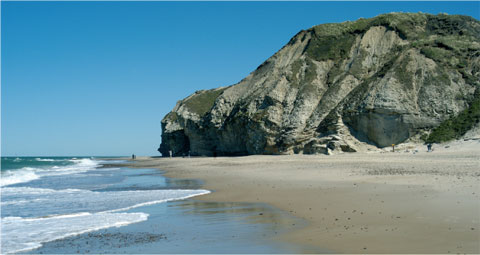
Threats to the coasts
Increased coastal erosion
Assumed sea level rises of 50 cm up to 2100 will increase the water depth locally and trigger or accelerate costal erosion which will exacerbate the retreat of the coastline. The west coast of Jutland between the towns of Hvide Sande and Thyborøn may retreat by up to 60 to 70 metres, if the erosion is not compensated by more beach feeding (Danish Academy of Technical Sciences (ATV) 2003).
Increased risk of storm flooding
Along Denmark's inner coastline, incidents of tidal flooding, which today are rare, will become commonplace following even slight increases in water levels. Changed wind patterns alone will mean that what today is a 100-year incident will become a 50-year incident, meaning the maximum water level occurring on average at 50-year intervals. If a sea level increase of 50 cm is added to this scenario, incidents which today are 100-year incidents will in many places happen annually. Hereby the risk of flooding increases, and, consequently, so will the need for adjusting the safety level for the about 900 km of dikes along Denmark's inner coastline.
Increased risk of flooding
More storm activity in combination with rising sea levels increases the risk of storm flood incidents s and flooding of still larger land areas. A sea rise of 0.5 m, for example, will reduce the present safety level of 500-1000 years for the dikes around Thyborøn to 50-100 years, and will in time necessitate reinforcement of the dikes if the safety level is to be upheld.
The Wadden Sea under threat
The Wadden Sea including the salt meadows along the southern part of the Jutland west coast is an example of a wetland area of international importance for migrating wading birds, which will be seriously affected by general sea level rises. Its location outside the dikes means that the salt meadows and the tidal flats are obstructed from following the coastline as it retreats inland and the natural area as we know it today will disappear.
Source: National Environmental Research Institute (NERI), Miljøtilstandsrapport 2005 (The State of the Environment in Denmark 2005). Danish Academy of Technical Sciences (ATV) (2003)
Summary
Denmark is among the countries in Europe with the largest area of land under the plough relative to its size. Furthermore, Denmark is also among the countries in Europe with the smallest natural area relative
to its total size. One of the reasons is that Denmark's inherent natural characteristics are very much suitable for agricultural production, and that Danish society has encouraged this development with financial
subsidies to drain small lakes and watercourses etc. As
a consequence, today there is far too little space for nature in Denmark. What natural areas do exist contain too many nutrients, too little water, and, moreover, they are too dispersed and on the way to
becoming overgrown.
In a number of areas there is now concrete and positive evidence of the extensive efforts which have been carried out over the past 20 to 30 years to conserve nature and reduce environmental impacts. Steps taken have thus provided good and visible results, such as a rise in the population of otter. However, efforts are still not out-balancing the negative development when it comes to wild animals and plants and their habitats.
Up until 200 years ago the sharp division in agriculture of farmed fields and natural areas was non-existent. Only a small part of the farmland was under intensive farming; that is, used to cultivate crops each year. The greatest part was used for extensive farming purposes with grazing and haymaking, which meant the creation of valuable meadows and dry grassland. Today, more than 90 per cent of farmland is subjected to intensive farming. Farms have become fewer and bigger with larger numbers of animal units. Via draining of small lakes and watercourses, and cultivation of former grazing areas, a majority of fields have grown ever larger in size. In intensive farming, it is often not feasible to let the animals out to graze, and this means that many open natural habitats, which have not already been turned into arable land, are becoming overgrown with scrub and trees.
The impact on habitats also impacts the species living there. The prevailing trend is that remaining natural areas in general are too few, too dispersed, and too poor in quality to serve as habitats for a substantial number of indigenous plant and wildlife species in Denmark; let alone sustain the processes which characterise a varied and well-functioning biological system. Orchid, barn swallow, hare, and butterfly are examples of species in decline.
Danish nature cannot endure the present intensive farming and nor the widespread discontinuation of extensive farming. No one expects us to restore the Danish landscape to the way it was a hundred years ago. It is however crucial that we provide nature and the biological diversity better conditions in the modern Danish cultivated landscape, so that e.g. the plenitude of species is not further diminished due to human activity.
At the same time, we need to do more to reduce the effects on biodiversity ensuing from climate change. This can be accomplished if we ensure greater variation, resilience, volume, and quality in our terrestrial and marine ecosystems. For example, ecosystem processes and nature's ability to adapt can be enhanced by ensuring more water in the Danish landscape; and there will be an equally positive influence on ecosystems if we take care to establish a coherent network of tree stands containing indigenous tree species, and good structure and long continuity in forests, hedgerows, small biotopes etc.
Indicator sources
- Statistics Denmark
- County of Funen
- National Environmental Research Institute (NERI) (2005): Natur og Miljø 2005. Påvirkninger og tilstand, (The State of the Environment in Denmark 2005, only summary available in English)
- Statistics Denmark
- Danish Forest and Nature Agency
- Statistics Denmark
- Danish Forest and Nature Agency
- National Environmental Research Institute (NERI) (2005): Natur og Miljø 2005.Påvirkninger og tilstand, (The State of the Environment in Denmark 2005, only summary available in English)
- Danish Forest and Nature Agency, Det centrale fredningsregister (the Central List of Protected Areas, only available in Danish)
- Danish Forest and Nature Agency
- Danish Ornithological Association's bird point source count: http://www.dof.dk/05_projekter/punkttaelling/forside.html, (only available in Danish)
- National Environmental Research Institute (NERI)
- Danish Forest and Nature Agency
- National Environmental Research Institute (NERI), survey of orchids: http://www2.dmu.dk/1_Om_DMU/2_Tvaer-funk/3_fdc_bio/ datasamlinger/orkide/baggrund_en.asp
- National Environmental Research Institute (NERI), seals in Denmark: http://www2.dmu.dk/1_Om_DMU/2_Afdelinger/3_AM/ 4_Expertise/5_Research/6_marine_mammals/seals_dk_en.asp
- National Environmental Research Institute (NERI)
- Danish Forest and Nature Agency and National Environmental Research Institute (NERI)
- Danish Meteorological Institute (DMI)
Other sources:
Danish Academy of Technical Sciences (ATV) (2003): Effekter af klimaændringer – tilpasninger i Danmark (on climate change effects in Denmark, only available in Danish)
EEA (European Environment Agency) (2004): Impacts of Europe's changing climate, Report No 2/2004
IPCC (International Panel on Climate Change) (2001):
Climate Change 2001: Impacts, Adaptation and vulnerability
Danish Forest and Nature Agency (2003): Skov og Natur i tal 2003 www.skovognatur.dk/udgivelser/tidligere/2003/tal_03.htm (nature and forest figures for 2003, only available in Danish)
Version 1.0 December 2005, © Danish Environmental Protection Agency